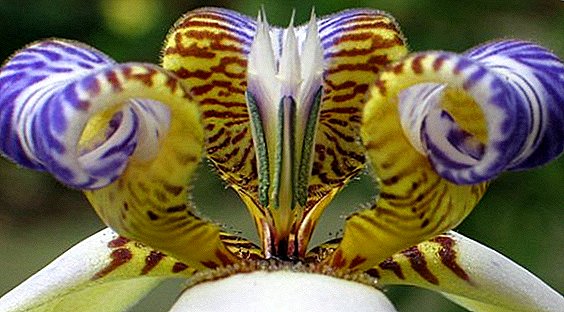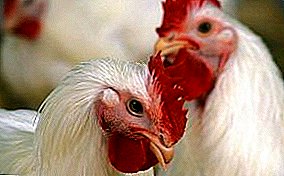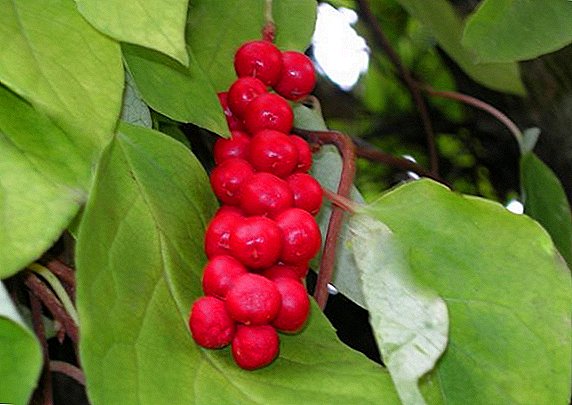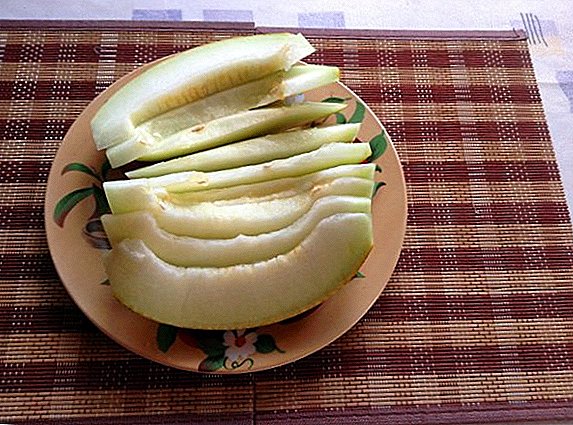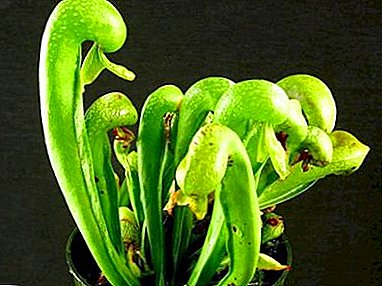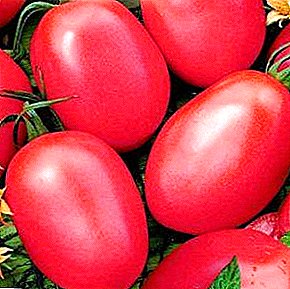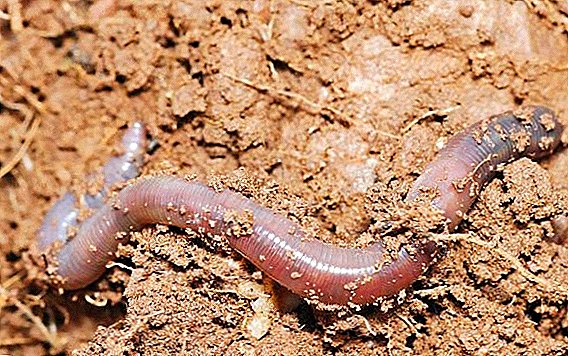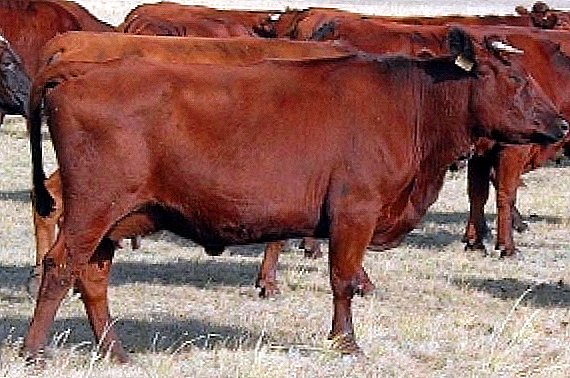
In households and farms, cattle are most often found for dairy purposes.
This is not the only direction in the productivity of cows, but it is more profitable and stable in terms of income. Indeed, for many of us, milk and dairy products are the basis of the diet, which is able to replenish the body with the most essential trace elements.
In the old days, cows were treated with special respect, as these animals were the bread-winners for our great-grandfathers. At present, we don’t have such affection for cows, but many continue to breed them.
We want to devote this article to just such people, having acquainted them with the beautiful dairy breed of red steppe cows.
The main features and value of the breed of red steppe cows for the dairy industry
The history of this breed is very long, since it is known in the Ukrainian steppes since the nineteenth century. It was bred by breeding, as a result of crossing a large number of different breeds of cattle. In particular, in the breed that we have today, the genes of the following cows are combined:
- Angelynskaya.
- Red Ostfriesland.
- Gray steppe.
- Simmental.
Genetic material and other dairy breeds that were popular at that time were also used, but the history did not even keep their names. But, breeding work with the described cows continues to this day.
Red steppe are crossed with bulls-inseminators of other breeds, since they are an excellent material for improving such characteristics as body build, udder shape and milk production. In particular, they help improve the Angler and Red Danish cattle breeds.
How not to make a mistake when buying a red steppe breed: the features of the appearance of animals

Outwardly, these cows do not have any remarkable features, except for the color of their suit. Moreover, the color can be presented with a very different intensity - from light brown to dark red.
Sometimes there are even white markings in the lower part of the body of cows. The bulls are darker in the upper and lower body.
The body of the representatives of the breed is elongated and slightly angular, although the constitution is dense but rather dry. Because of the elongated body, the back is also very long, but flat.
The chest of these animals is deep, but not wide, almost flat. Their dewlap is practically undeveloped. The loin is wide, although it is medium in length.
Their belly, like all dairy cows, is very voluminous, since the ribs are set wide apart. But, belly does not droop even when carrying a calf.
The legs are quite strong, straight and stable, but these cows are not well adapted to fermentation on uneven terrain. In growth they are not tall, which helps animals to more easily carry their enormous weight.
The whole bones are quite light and very gentle. The skin of cows is very elastic, because over the course of a year, they periodically either gain or lose weight. But in general, the musculature of these animals is rather poorly developed, although they also have meat value.
The head of the red steppe cows is very light and small in size. It has a slightly elongated shape, passes into the body through a thin neck. Because of the dark shades of color, the nasal mirror is also dark. The horns are small, light gray in color, wrapped inwards.
Concerning basic measurements representatives of the described breed, they indicate the small size of this cattle:
- The height of the animal at the withers reaches 126-129 centimeters, although their withers are a little pointed.
- The slanting length of the entire body can range from 152 to 156 centimeters.
- The chest is very deep and it measures 66-68 centimeters.
- The measurements of the width of the chest are 37-42 centimeters.
- The metacarpus in girth is 17-19 centimeters.
What should be the udder of this representative of the red steppe cattle?

Udder can also tell a lot about its owner, especially when it comes to dairy breeds of cows. The red steppe cattle udder has a rounded shape, that is, a bit like a truncated cone.
However, livestock breeders note that an udder with an irregular shape is quite common. But it is the round shape that indicates that these cows are well suited for machine milking.
But still, you need to be very careful that in the nipples, which are cylindrical in shape and can be bent with milking cups, there is no milk left.
Nipples are comfortable enough for manual milking, since the length of the front ones is on average equal to 6.5 centimeters, and the rear ones - 5.7.
In size udder is not very bigbut well developed. By type, it is ferrous in red steppe cows, which is most desirable for dairy cows. This means that the udder is very soft during milking and is able to strongly stretch when milk is accumulating.
But after milking, it decreases significantly, forming small folds on the back wall.
It is also interesting to read about the features of milking a cow.
Advantages of keeping and breeding cows described breed
It is rather naive to think that the breed of a cow should be chosen solely for its dairy characteristics. After all, how productive it would not be, with poor adaptability and health, the maintenance of such an animal will only bring losses.
Fortunately, the red steppe cows are good in this respect, since the following are characteristic of them. merits:

- As representatives of the steppe range, these cows are very easily adapted to almost any conditions.
They are best suited for breeding in the southern regions with a rather hot climate.
Most importantly, under the scorching sun, these animals are able to feel very good, although it is better to provide shelters or forest edges in the pasture territory, in the shadow of which the cows could take shelter.
It is very important that even with very strong and prolonged summer droughts, animals are able not only to maintain the stability of their weight, but also to feed additional reserves on the most meager and burnt steppe pastures.
- They also adapt to any weather conditions without problems, so that neither wind nor rain will bring any harm to the red steppe cows.
All these facts testify to the excellent ecological endurance of livestock, which allows it to easily multiply, making its numbers even more significant, without any human intervention.
In addition, animals show a strong maternal instinct, taking care of their offspring for a very long period of time.
- Both young animals and adults are distinguished by excellent immunity.
In consequence of this, the impact of various external adverse conditions and viruses on red steppe cattle is simply uneasy. They stand firmly against not only respiratory diseases, but also leukemia, which is very common among cattle.
For dairy cows to which this breed belongs, this is very important because a disease like leukemia can have a rather negative effect on milk production.
What are the weaknesses characteristic of the breed: discuss their features
Despite the fact that the described breed of cows has very convenient for milking machine udderThis method of obtaining milk very often leads to the appearance of mastitis.
After all, the milking cups of the milking machine can bend over the nipples, as a result of which all the milk does not come out of them. The fact is that among representatives of the breed, the udder often has an irregular shape and not exactly uniform shares.
For this reason, before you finish the milking process, it is very important to slightly lower the cups from the nipples and massage udder, and only then complete the milking. Also, it is worth doing massages to cows constantly. With their help, milk yield is significantly increased.
Among the others weak sides of red steppe cows It is worth paying attention to:

- A rather weak musculature, which in combination with a soft bone often leads to injury to animals.
In this regard, it is very important to pay attention to the pasture relief for grazing, on which animals can dislocate their paws.
- These cows are also not weighed much, which does not allow for the production of very high meat productivity from them.
- Narrow and slightly drooping back of the body, the possibility of manifestations of the defects of the back of the body.
What conditions of maintenance are necessary to provide red steppe cows?
To the conditions of these cows have virtually no special requirements. The most important thing for them is the availability of food supply, and not necessarily the best one.
They can eat the simplest steppe grass, while giving rather good results in milk production. But to keep the red steppe breeds on year-round grazing is still not recommended.
Being perfectly adapted to hot weather conditions, they do not tolerate the frosty temperatures. Therefore, it will be necessary for winter time. prepare a barn for animals and good stocks of hay.
Heating a room with cows is not necessary. Even in the presence of dairy calves, the cows themselves will take care that they do not freeze.
Red steppe cows can be kept not only by numerous herds, but also individually. Animals will feel great in both cases.
The only caveat: it is better not to keep seeding bulls together with all the cows, and especially with calves. If the bulls were castrated at a young age, they are grazed along with the rest of the cattle.
But at the same time, it is very important to provide calves with an opportunity to move a lot from a very early age, not only indoors but also outdoors.
Feed for young stock should also be more nutritious and high quality. Otherwise, they may develop defects of the back of the trunk or improper setting of the limbs. As a result, the productivity of such animals decreases significantly, mortality occurs very quickly.
What are the performance indicators to strive for when keeping red steppe cows?
In qualitative and quantitative characteristics of productivity, red steppe breed is slightly inferior to other dairy breeds. However, due to its stability and good exterior, its popularity still remains high.
In Russia, this breed is in second place in terms of the number of individuals. Today, it continues to improve and, on the basis of its new breeds of cattle.
Milk productivity: characteristics of milk yield and milk potentials

Experts note that the milk productivity of red steppe cows can vary significantly depending on which climate zone animals are kept in.
In the most ideal steppe conditions for the breed, the average milk yield is 3000–3500 kilogram of milk per year.
This index is very strongly reflected in the feeding and content, due to which the amount of milk can increase by 500-1000 kilograms.
But, record milk yield results from the red steppe rocks were even 10-12 thousand kilograms of milk for one lactation. The protein content of milk red steppe cows is considered very useful, since its percentage can vary from 3.2 to 3.6.
But, in terms of fat content, this breed is a little behind. On average, it is only 3.6-3.7%, although it is believed that the fatter cow's milk, the better it is.
It is also noted such a pattern that with an increase in milk production, the indicator of fat content may decrease. But still, there are individuals in which the quality and quantity of this product completely coincide, which is quite strongly influenced by the food supply provided by the animals.
Is it possible to let the red steppe cows for slaughter: the yield obtained and the features of animal meat
Another feature of the described breed is that among its members there are very often individuals that have pronounced meat and dairy characteristics, or only meat. Therefore, in meat production red steppe cows also quite valuable, even despite the small size of their torso.
The live mass of the representatives of the breed varies considerably depending on the sex of the animal:
- At birth, the mass of chicks is 26-35 kilograms. Cows after three calving and at an older age can weigh from 450 to 520 kilograms.
- Gobies are born weighing from 30 to 40 kilograms, and by the onset of puberty they usually reach 800-900 kilograms.
With the most common fattening meat yield of this breed is usually about 50-55%. However, if an intensive feeding system is applied to young bulls and oxen, this indicator may slightly increase.
The beef obtained from this breed does not differ in any particularly high qualities, although in general it has good taste and juiciness. The fatness and tenderness of meat directly depend on the type of feeding and the age of the animal.
It is believed that the meat of cows, which are constantly kept on free grazing, and fed with hay in winter, has higher taste characteristics.
Fertility of the red steppe breed: we are engaged not only in keeping, but also breeding cows

In order for a cow to have milk all the time, it must be inseminated about once a year. Due to this, a full-fledged lactation process takes place, milk yields are increased, and also reproduction of livestock is carried out.
It is worth noting that fertility of this breed is at a very high level: an average of 100 calves per 100 cows. The advantages of breeding red steppe cows should also include:
- Easy calving. A cow in this process does not require human intervention, unless it has been traumatized before it and has no vices.
- Good maternal instinct, which is shown in relation to the calves, not only their mothers, but also other representatives of the herd.
- The precocity of animals described breed.


